
The garden dart is a moth of the family Noctuidae. It is distributed throughout much of the Palearctic. Temperate regions of Europe, Central Asia and North Asia, as well as the mountains of North Africa. Absent from polar regions, on Iceland and some Mediterranean islands, as well as in Macaronesia.

Acronicta auricoma, the scarce dagger, is a moth of the family Noctuidae. It is distributed through most of the Palearctic.

Acronicta cuspis, the large dagger, is a moth of the family Noctuidae. It is distributed through most of Europe, Northern Africa (Morocco), the European part of Russia, the Caucasus, the Russian Far East, southern Siberia, Transcaucasia, central Asia, China, Japan and the Korean Peninsula.

Acronicta menyanthidis, the light knot grass, is a moth of the family Noctuidae. It is distributed through northern, central and eastern Europe, east to Siberia and the Russian Far East.
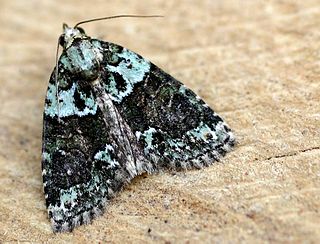
Cryphia algae, the tree-lichen beauty, is a moth of the family Noctuidae. The genus was erected by Johan Christian Fabricius in 1775. It is found in Mediterranean parts of Europe and the Near East.

Euxoa obelisca, the square-spot dart, is a moth of the family Noctuidae. It is found in the Palearctic realm.

Enargia paleacea, the angle-striped sallow, is a moth of the family Noctuidae. It is found in the Palearctic realm from Ireland to Siberia East to Japan.
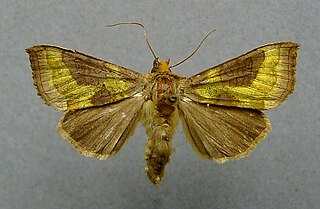
Diachrysia stenochrysis is a species of moth of the family Noctuidae. It is found in Europe, the Caucasus, the Far East, Primorye, Ussuri, Korea, Manchuria, Mongolia, Transbaikalia, Siberia and Japan.

Euxoa cursoria, the coast dart, is a moth of the family Noctuidae. It is found in northern and central Europe as well as the coastal regions of the British Isles, central Siberia, Mongolia, Tibet and Afghanistan. The subspecies Euxoa cursoria wirima is found in Canada.

Sedina buettneri, or Blair's wainscot, is a moth of the family Noctuidae. The species was first described by Eduard von Hering in 1858. It is found in the Palearctic realm. Outside of Europe, it is occasionally found in temperate Asia, the coast of the Black Sea, the base of the Caucasus mountains, the Caspian Sea, Iran, Russia east to the Urals, Lake Baikal and Altai regions, and in Japan and the Kuril Islands.

The green-brindled dot is a species of moth of the family Noctuidae. It is found in Southern Europe and the Middle East, then east up to Iran and Ukraine. In Germany it is found up to the Eifel and Ahr.

Agrotis cinerea, the light feathered rustic, is a moth of the family Noctuidae. The species was first described by Michael Denis and Ignaz Schiffermüller in 1775. It is found in southern and central Europe, northern Turkey, the Caucasus, western Turkmenia and Central Asia.

The shoulder-striped clover is a species of moth of the family Noctuidae. It is found in most of Europe, Ukraine, southern Russia and southern Siberia, Transbaikalia, Turkey, central Asia, China, Japan, the Korean Peninsula, Mongolia, northern India, Pakistan, the Russian Far East.

Euxoa conspicua is a moth of the family Noctuidae. It is found in Portugal, Spain, Andorra, France, Italy, Corsica, Crete, Cyprus, Romania, Bulgaria, Greece, Ukraine and southern and eastern Russia, east to China and northern India. It is also present in the Levant.
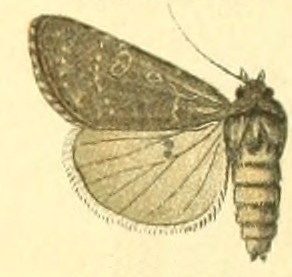
Euxoa birivia is a moth of the family Noctuidae. It is found in Europe, east to Ukraine, the Caucasus, Armenia, central Asia, Ili, Issyk-Kul, Turkey and Iran.

Dichagyris forcipula is a moth of the family Noctuidae. It is found from central and southern Europe and Algeria, east to the Caucasus, Turkey, Syria, Lebanon, Iraq and Iran.
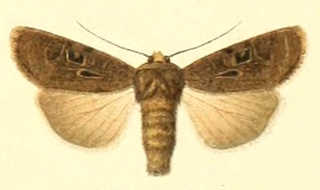
Chersotis andereggii is a moth of the family Noctuidae.

Dichagyris constanti is a moth of the family Noctuidae. It is found in Algeria, Morocco, south-western Europe, southern France, and northern Italy. Warren (1914) states E. constanti Mill. Forewing pale yellow, dusted with darker especially in median area; the lines fine ; the subterminal punctiform ; stigmata very faint ; hindwing white, with the fringe and margin yellowish.Recorded only from the Ardeche, France.

Chersotis larixia is a moth of the family Noctuidae. It is found in Spain, France, Switzerland, Italy and Sicily, Crete, Turkey, and east to Armenia, Azerbaijan, Syria, Iran, Lebanon, and Turkmenistan. In Europe, it is found in mountainous regions, like the Pyrenees, the Alps, and the Maritime Alps, up to heights of 2,000 meters.
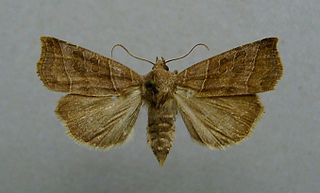
The double kidney is a moth of the family Noctuidae. It is found in most of Europe. In the east, the range extends through Turkey, Siberia, Mongolia and China to Korea and Japan. The habitat consists of damp marshy places.




















